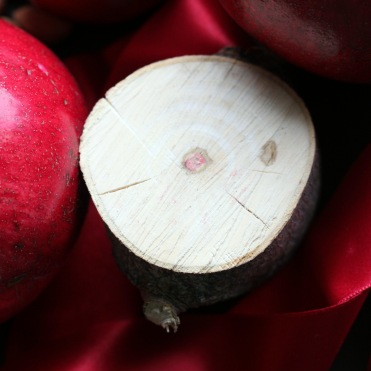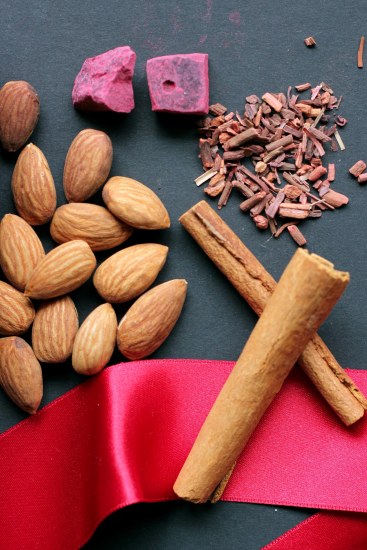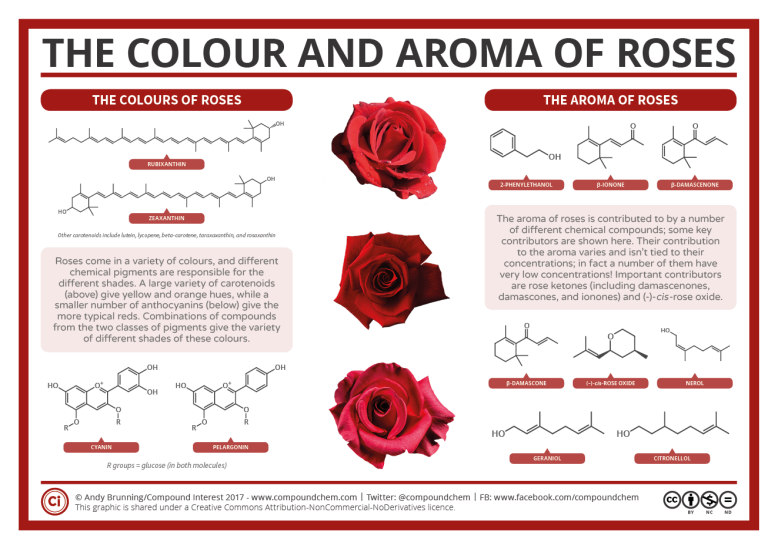A few months before Pantone’s year of “living coral“, I started to think about the color red. Maybe it was watching The Handmaid’s Tale or being pregnant, but something made me ask if there was such a thing as a red scent.
Maybe it had something to do with being a soap maker and thinking about red soap, and about what scent blend would go with the color. During the year I did make some red swirled- and red-themed soaps. I experimented with two slightly different scent blends: 1) star anise, black pepper and lemongrass. 2) rose geranium, palmarosa and star anise. As far as color-scents go, I’d have to say the first one smells more red. I think the lemongrass really added the clarity I associate with red.

The full log of Australian Red Clay soap by Flora & Pomona
As the year went on my exploration of red was put on hold. About a year later just this past December, it came back to me as I started to unpack the Christmas boxes. Down in the cavernous basement were my boxes filled with glossy red ribbons, red velvet stockings, candles, and sparkly ornaments lined up like rubies in the box. There really couldn’t be a better season to explore the color red than the Christmas. It’s a special kind of color; the red of fairy tales, of saint’s sashes, of resins and rubies; the clarion tone of poinsettias, Santa’s costume and holly berries. And nothing smells more like Christmas, to me anyways, than the scent of clove-studded oranges, ginger cookies and a cup of steaming mulled wine, with almonds and raisins. Then there’s sealing wax, the Christmas tree and that waxy scent of hot house flowers.
But are those things merely related in our minds by association? Can a color really have a scent? If I close my eyes and think of what red smells like, my olfactory imagination brings up a vibrant, bright yet dense note. Not precisely a floral, rather some mix between resins and carnations – not terpene-y, pine type resins, but a benzoin type resin. Then, following in closely, in that same exotic tree category, maybe some cloves. Then to clear up the notes and get the vibrancy of say, a glass of merlot, maybe a dash of something juicy and tart, like pomegranates. Then a waxy hot house floral, and finally a whisp of root and earth. Maybe a dab of funk too. Leather, perhaps.
I pondered this last one as I poured myself a cup of dark red raspberry leaf infusion. Was it the animalistic aspect? Red like blood? Carnivorous meat-red? But meat doesn’t smell like leather. Leather is tanned… then it hit me: tannins! The smell of leather derives mostly from the tanning process in which plant tannins are often used. It is also what makes raspberry leaf infusion (and regular tea for that matter) so dark and astringent. It is also present in many trees, most notably oak and chestnut trees. The word tannin even comes the latin word for oak bark, traditionally used for tanning hides. And what about those red wines aged in oak barrels? Tannin allergy anyone? But alas, it turns out tannins are odorless…

- A slice of pincherry wood, notice the red center.
Ok, so then leather wouldn’t smell like tannins per se… Perhaps the color tannins yield has become associated with the scent of curing organic matter, as in, something gone bad. Or maybe the scent of the plant materials themselves: what do oak trees, chestnut trees, raspberry bushes, and grapes have in common, besides tannins?
My first online inquiry into the scent of the color red yielded different studies. One said that some people associated the scent of cinnamon to the color red, and yet another that said Australians link the smell of almonds to the color red. If I had to cast my vote I would have to say almonds, but bitter almonds. So what do almonds smell of?

Have you ever tasted an apple-seed, or sucked a cherry pit too long? Tastes just like bitter almonds. Apparently this flavor or scent, amygdalin “is found in many plants, but most notably in the seeds (kernels) of apricots, bitter almonds, apples, peaches, and plums“. It breaks down into benzaldehyde, which in turn can be oxidized into benzoic acid which incidentally got its name from…. gum benzoin, which was for a long time its only source.” Some researcher named Ludy studying benzoin in the early 20th century “reached the conclusion that benzoin balsam was produced from the tannin of the bark.”
I feel like I’ve stumbled on something here, but what does all this mean? Are tannins and benzaldehyde interrelated? Is amygdalin a marker of the rosaceae and are benzaldehyde and benzoin sister notes, vibrating at the same frequency? Does the “benz” in both mean they’re related and does this have anything to do with benzin (as in gaz)? Is that why I like the smell of gaz? Any chemists out there, let me know! But let’s look at some plants that contain benzaldehyde:
- Black walnut. Also coincidentally, very high in tannins.
- Perilla frutescens also known as beefsteak mint. Never heard of it. Can only guess why it’s called beefsteak mint: is it red?
- Rooibus tea. Very red indeed, and also high in tannins.
- Horse chestnut. Very high in tannins but not edible. Are edible chestnuts also high in tannins and benzaldehyde?
- Almonds. Yes for the bitter almonds, and also the skins are reddish due to tannins.
- Cinnamon, also contains tannins, but is not overly astringent. Infusing the bark creates a red liquid, and it is carminative (i.e. warming).
- Camellia sinensis, or tea. Very high in tannins also.
So maybe the scent of benzaldehyde is associated with red because it often occurs in trees and bushes with lots of tannins, many of which produce either sweet smelling resins or blushing fruits with almondy smelling pits and seeds. So what does this mean? Red smells like benzaldehyde, or the other way around? Or red smells like tannin-rich plants? Or red smells like stone fruits?
How about the carnations that keep popping up in my mind? Neither fruit nor tree, Fragrantica describes the scent of carnations as follows: “It possesses floral spicy scent with pepper and clove nuance. Carnation is often used in classical fragrances due to its spicy peppery scent that deepens floral notes, and is especially effective combined with rose scent.” Aha, so it smells like something else – an aromatic (warming) flower-bud of a tannin-rich tree. But what gives clove its characteristic odor? Apparently the major aroma component of cloves is eugenol, which is an “aromatic oily liquid extracted from certain essential oils especially from clove oil, nutmeg, cinnamon, basil and bay leaf.” Are there tannins in cloves? Let’s see: “other gallic acid derivates as hidrolizable tannins are present in higher concentrations” So yes, some form thereof. Where else do we find higher amounts of eugenol besides cloves? It’s also found in allspice, bay rum tree, roses, and rooibos-tea.
So what about pomegranates?  Neither part of the roseacea family, nor an actual tree, it’s not a spice nor a resin. Why would they smell red besides their obvious color: “The scent of pomegranate is subtle, distinct, twisting the green powdery fragrance of its skin around the sweet-tart and winey aroma of the seeds.” Ok, the orange peel-like white on the inside of the skin is a giveaway – it’s astringent smelling, hence the “green powdery fragrance.” Why does it smell tart and winey? Perhaps the chemical compounds are connected to the color: “Primarily, the pigmentation of pomegranate juice results from the presence of anthocyanins and ellagitannins”. Ellagitannis are a “diverse class of hydrolyzable tannins” hydrolyzable means they are capable of undergoing “hydrolysis; decompose by reacting with water.” So, as far as I can tell, they are essentially tannins. The anthocyanins (you may recognize the word cyan from photoshop meaning blue) are pH variable pigments, meaning they are capable of producing various colors depending on the pH levels.
Neither part of the roseacea family, nor an actual tree, it’s not a spice nor a resin. Why would they smell red besides their obvious color: “The scent of pomegranate is subtle, distinct, twisting the green powdery fragrance of its skin around the sweet-tart and winey aroma of the seeds.” Ok, the orange peel-like white on the inside of the skin is a giveaway – it’s astringent smelling, hence the “green powdery fragrance.” Why does it smell tart and winey? Perhaps the chemical compounds are connected to the color: “Primarily, the pigmentation of pomegranate juice results from the presence of anthocyanins and ellagitannins”. Ellagitannis are a “diverse class of hydrolyzable tannins” hydrolyzable means they are capable of undergoing “hydrolysis; decompose by reacting with water.” So, as far as I can tell, they are essentially tannins. The anthocyanins (you may recognize the word cyan from photoshop meaning blue) are pH variable pigments, meaning they are capable of producing various colors depending on the pH levels.
Like tannins, anthocynanins are odorless and also “moderately astringent” and they exist in vegetables and fruits such as blueberries, beets, red cabbage, black currants and, surprise (!), also in roses, raspberries, blackberries, cherries and plums. So my guess is that the more tart-sour-acid the environment the more red it turns. Hence, the color red would be an indicator to our noses, or rather, to our mouths, of tart-sour. Perhaps the tarter the fruit, the redder it is. Is there a bright red fruit that isn’t tart? Maybe watermelon or papaya… BUT their rinds are green, so not sure that counts. We’re looking for visual cues of tartness. Neither papaya nor water melons are tart, and hence, nor do they signal tartness with their rinds. If you know of any exemptions, let me know!
I’m starting to think that red may not only have a smell but rather, a taste and a sensation, some combination of astringent (drying), aromatic (warming), and tart, and maybe a touch of bitter. Of course, it’s very difficult to dissociate taste and smell.
But let’s look at what a professional nose thinks the color red smells like. The classic perfume “Red Door” by Elizabeth Arden came out in 1989 (three years after Chris de Burgh’s 80s classic The Lady in Red).
It was made by nose Carlos Benaim and is classified as an oriental floral and its main accords are floral, sweet, woodsy, and spicy. So how did Benaim achieve a red composition, if indeed that was what he intended?
Let’s look at some of the individual notes. Top notes of anise, orange blossom, plum; mid notes of rose, orris, and ylang-ylang; base notes of sandalwood, cedar, benzoin and musk. Other prominent notes are: carnation, jasmine, tuberose, vetiver, and amber. Here red is something warm and aromatic, powdery-woodsy and oriental-floral, and maybe a little bit dirty. But this could be any perfume you say! Perhaps. There is also the subtle art of perfumery in play, notes balanced just so, creating an olfactory impression greater than the sum of its parts. The aromatic compounds play footsies, winking at each other from across the notes. For example, eugenol features in roses, tuberose and carnation, and so forth. Then of course, there’s the idea that nothing makes a sweet scent smell sweeter than a touch of ass (I say this without judgment for the scent of ass. Let’s assume that in perfumery there is no good or bad aroma compounds, only bad compositions). So not every note needs to smell red or be red, it need only complement or enhance the red notes. The same principle works for colors: nothing makes red pop like green.
But still, there’s a red thread there, and many of these notes contain the same aroma compounds in varying degrees, linking the notes to each other like some kind of olfactory rhyme scheme. Which reminds me of wine. In fact, many of these notes are typical tasting notes in red wine. Let’s see what the Decanter.com has to say about understanding tasting notes: “Wines that have had contact with oak barrels, staves or chips can pick up sweet spice notes from the wood because it has a similar aromatic profile. For example, the aroma compound eugenol is found in both oak and Christmas spices like cloves, nutmeg and cinnamon.” Ah yes, the Christmas spices…
Moving on to tuberose, another note in Red Door. Tuberose isn’t a red flower or red fruit, it isn’t part of the roseacea family, it isn’t a red resinous tree like cedar or sandalwood. However, one significant aromatic compound in tuberose is “methyl benzoate,” also “presented in the essential oil of ylang-ylang.” It has “a pleasant smell, strongly reminiscent of the fruit of the feijoa tree, and it is used in perfumery” Never heard of this tree, but it turns out it belongs to the Myrtaceae family of trees, just like cloves, allspice, laurels, the bay rum tree, eucalyptus, guava. It’s also present in bananas, cherries, coffee and black tea. So these two aroma compounds tend to come together in this group of tropical trees that produce edible fruits and spices. I wish I knew what methyl benzoate smelled like, perhaps it’s that waxy component I’ve been looking for.
But clearly, these compounds exist in thousands of plants, and so it’s a case of specific blends and concentrations. Still, it can’t be a coincidence that the flower is called tuberose and that they are both high in eugenol: “The floral volatile compound eugenol is an important constituent in many aromatic plants, being a floral attractant for pollinators as well as having antimicrobial activity. Rose flowers emit eugenol and its derivatives.”
What other compounds do we have in this red puzzle. How about geraniol which “In addition to rose oil, palmarosa oil, and citronella oil, it also occurs in small quantities in geranium, lemon, and many other essential oils. With a rose-like scent, it is commonly used in perfumes. It is used in flavors such as peach, raspberry, grapefruit, red apple, plum, lime, orange, lemon, watermelon, pineapple, and blueberry.” Ok, so fruits and berries with lots of phytocyanins, lots of acids, and stone fruits from the roseacea family.
Now let’s move on to the rose and its scent, which is so emblematic of the color red.
Red roses, thorns and all, are a symbol of romance, love, carnality. Physical heat, yes, but perhaps not yet consumed. The tingly red of seduction, rather than say, the narcotic post-coital lull. More Red Door, less Opium by YSL (Opium is also a floral oriental, but has stronger earthy/animalistic notes of castoreum, labdanum, and patchouli).
A rose by any other color, would it smell as sweet? I don’t know. Does a white rose smell red and does it even smell sweet? What makes the red rose red then? You guessed it: mostly anthocyanins (is this why rose petals are astringent?). The rose, depending on its color, also has carotenoids, which is responsible for the orange/yellowish colors we also see in sweet potatoes, oranges, carrots etc. I’m assuming, it’s also what makes the rosehip, the fruit of the rose, so orange. The chemical compounds mainly responsible for the sweet heady scent of rose are called rose ketones, and these are also “found to contribute to the scent of apricots, beer, blackberries, grapes and wine, kiwi, mango, papaya, passion fruit, rum, raspberries, tobacco, tomato, tea, and many more.” Other compounds that make minor contributions to the aroma include geraniol, nerol, (-)-citronellol, farnesol, and linalool. But it turns out it’s not the anthocyanids, which make roses and pomegrantes red, that are tied to the rose ketones, it’s the cartenoids: the biological origin of the rose ketones is the oxidation of carotenoids.
Ahhh is that why boiled carrots smell like roses ? There it is again, decay. “A rose will bloom, and then it fades…”. Death is so essential to our appreciation of beauty.

Olivia Hussey as Juliet in the 1968 film adaptation of Romeo and Juliet
But maybe it’s not so much dead, as ripe for eating? The rose petals smell good, perhaps good enough that we keep an eye on it and wait until the fruit is ready (perhaps ditto for apples and all the other stone fruits), and it’s the fruit that is really good for us. Perhaps astringency signals “not ripe-ness,” and tartness signals “could be yummy and full of vitamin C” and the red color says “interesting, but be wary”?
So we return to the simple almond. More precisely the bitter almond, which so many people associate with the color red: “It also contains the enzyme emulsin which, in the presence of water, acts on the two soluble glucosides amygdalin and prunasin yielding glucose, cyanine and the essential oil of bitter almonds, which is nearly pure benzaldehyde, the chemical causing the bitter flavor.” Pure benzaldehyde ahhh smells amazing! But you know, bitter almonds can kinda kill you. And let me just say, I love the smell of bitter almonds. But perhaps it screams “red” to alert us to the danger of cyanide (which is colorless and often odorless). Who knows!
Maybe this is the seed’s way of protecting itself? Maybe clove buds, since they are flowers, want to be pollinated but not eaten? Ditto the seeds? Maybe the cinnamon tree produces its hot tingly chemical compounds specifically in the bark to ward off munchers.
What about the tannins? Well, they are often used by plants to protect themselves not just against fungi and bacteria but foraging animals. The astringency in tannins are also used medicinally: “Tannins also play a role in medicine and human health. Remember that tannins are astringents that tighten pores and draw out liquids.” On the same page just quoted, it mentions cranberries and their high tannin-content, and it’s usefulness in staving off UTIs.
I am starting to think the scent red is purely associative, not only to color but mostly to taste, and it is this way because in nature these things hang out together. And why do they hang out together? Let’s say that it’s because the aromatic compounds of the plants – both odor and taste – are tools. The plants use them a) for protection, as anti-fungals, anti-bacterials etc. and b) to signal to animals. Color and odor (and flavor) work together as a language, and it is only a language because someone on the receiving end is understanding it. We understand, on some elemental level, that if a plant (seed, bud, bark etc.) smells strongly aromatic that it’s probably not food, but that it may be medicinal, or need some kind of preparation (cooking, fermenting, drying etc.). Astringent or super sour fruit = not ripe yet, or possibly, not edible. It’s a warning sign, a stop sign if you will, for us to proceed with caution.

Let’s view this from yet another angle. We perceive these things – like cloves, cinnamon, bitter almonds, bitter oranges, raspberry leaves, rose petals – as having red scents because they have a warming and drying effect on the body in some way. And when we encounter other more exotic things that smell like these kitchen herbs, we associate them: carnations smell like cloves. It’s not the other way around. They are carminative, stimulants and digestives, and perhaps the most obvious ones are a mix of all these: literally warming up the mouth, tingling (like cinnamon), warm up our digestive system like bitters do, cause our mouths to pucker and feel dry like tannins do, smart our tongues the way acids do.
And why not go further out on a resiny limb: perhaps the scent-color red derives from fire, not only because of fire wood or burning resins, but because it is warming, drying, necessary and deadly. It is both seductive and dangerous. Lady in red, and stop signs. Cranberries = yes. Holly berries = no.
So to summarize, I believe what most people think smells red comes from 1. Edible plants, because smell and scent are hard to differentiate between. 2. Plants that produce heat in our bodies, heat being something we perceive as red, due to fire perhaps, or due to how our bodies react to these stimulating and carminative actions (we get red and feel warm). 3. Tart things. Why this is, I do not know, especially since it contradicts my previous statement. Tart things are considered to be cooling, not warming. My best guess is that many tart things happen to be red. 4. Things to be consumed with caution, or in small quantities. These may often be medicinal in some way. Berries especially fall into this category. Think of elderberries. The berries are ok, but not the leaves, or the stems. Or, raspberries. Berries are great, but beware of the thorns. Point 3 and 4 conflate a bit here on the sweet-tart element of red. Although blue berries and red berries get their coloring from the same anthocyanins, blue berries are often sweeter, and the red berries, tarter. Generally and herbally speaking, the sweeter something is, the less likely it is to be bad for us.
So here we are, Christmas is over: I’ve over-eaten ginger cookies again, eaten marzipan by the ball-full (yes… I have a marzipan problem), and drunk my fair share of cinnamon and hibiscus tea. We didn’t get a white Christmas this year, but it’s snowing now and of course, I can’t help but wonder if maybe we have adopted these things as holiday items because we need to stay warm and dry. Or maybe those were the aromatics and products we have had available to us here during the winter, and maybe they kept so well because of their pungent, aromatic nature.
Happy new year and stay warm and dry this winter season. Join me next, in part two of this series: making a red soap.
[Disclaimer: as you may have noticed, I am not a chemist, perfumer, botanist or certified herbalist. I am merely a curious person, a soap maker and you know, generally into plants. This blog post is a representation of my own conjectures and hypotheses, and attempt to navigate and explore the idea of the scent red. I acknowledge my northern European and North American bias, as these are the two places I have lived: the idea of the scent-color is probably very subjective, and changes depending on cultural context]. Thank you for reading!




One thought on “The Scent of Red”